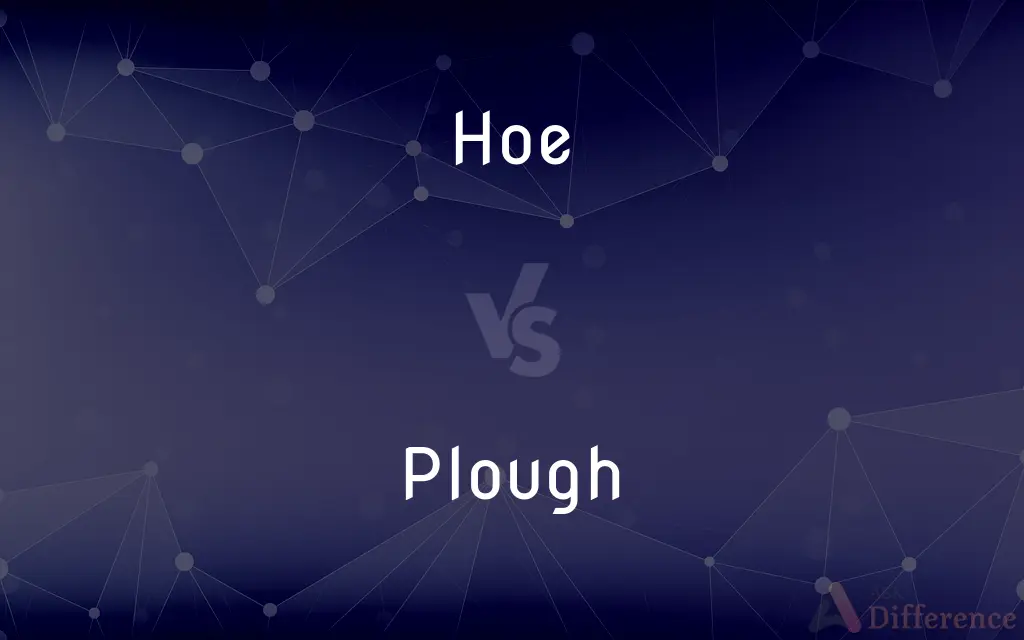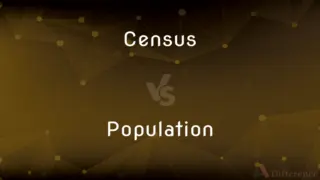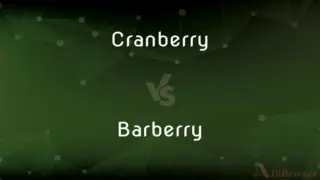Hoe vs. Plough — What's the Difference?
By Urooj Arif & Fiza Rafique — Updated on March 22, 2024
A hoe is a hand tool used for shaping soil, removing weeds, and harvesting root crops, whereas a plough is a large farming implement drawn by animals or tractors, used for turning over and breaking up soil.

Difference Between Hoe and Plough
Table of Contents
ADVERTISEMENT
Key Differences
A hoe is primarily used for smaller gardening and farming tasks, such as weeding and aerating soil around plants. It is a versatile and simple tool, consisting of a flat blade attached to a long handle, allowing the user to work while standing. On the other hand, a plough is designed for larger agricultural fields, preparing the soil for seeding by turning it over and breaking up large clumps. This implement is much larger and requires animal or mechanical power to operate, making it unsuitable for small-scale gardening tasks.
While a hoe is manually operated and gives the user direct control over the precision and force applied, a plough is typically attached to a tractor or drawn by animals, making it less precise but much more efficient for preparing large areas of land. The hoe's simplicity and ease of use make it a staple in small gardens and for tasks that require careful attention to detail. Conversely, the plough's design and operation are optimized for large-scale farming, where efficiency and the ability to prepare vast tracts of land quickly are paramount.
Hoes are often used for tasks like shaping soil into rows or mounds for planting and for removing weeds close to crops without damaging them. This level of precision and gentle handling of the soil is something ploughs cannot offer due to their size and method of operation. Ploughs, on the other hand, are designed to invert and aerate the soil to a significant depth, which is essential for the growth of crop roots and helps in burying crop residues and weeds which act as green manure.
In terms of maintenance and costs, a hoe is generally low-maintenance and affordable, making it accessible to almost anyone with a garden. Its simple design means there are few parts that can break or require maintenance. Ploughs, however, are more complex and significantly more expensive, requiring regular maintenance of their mechanical parts and the animals or tractors that pull them. This makes ploughs a more substantial investment, primarily used by professional farmers.
Despite their differences, both tools play crucial roles in agriculture. The hoe is indispensable for small-scale gardening and precise tasks, offering unmatched control and simplicity. In contrast, the plough's ability to prepare large fields efficiently makes it essential for modern agriculture, where time and labor efficiency are key.
ADVERTISEMENT
Comparison Chart
Usage
Small-scale gardening tasks
Large-scale soil preparation
Operation
Manually by hand
Animal or tractor-drawn
Function
Weeding, aerating, shaping soil
Turning over, breaking up soil
Precision
High, suitable for close work around plants
Low, designed for efficiency over large areas
Cost & Maintenance
Low cost, minimal maintenance
Higher cost, requires maintenance
Compare with Definitions
Hoe
A hand tool for gardening.
She used the hoe to create a small mound for planting.
Plough
A farming implement for soil preparation.
The farmer hitched the plough to his tractor to start the spring fieldwork.
Hoe
Ideal for small, precise tasks.
With her hoe, she carefully shaped the soil around the delicate seedlings.
Plough
Requires animal or mechanical power.
In the past, oxen were commonly used to draw the plough through fields.
Hoe
Requires manual operation.
They spent the afternoon hoeing the vegetable garden to aerate the soil.
Plough
Integral to modern farming.
The introduction of the mechanical plough revolutionized agriculture, increasing productivity manifold.
Hoe
Versatile in small gardens.
The hoe proved to be the most useful tool in her urban garden.
Plough
Used in large-scale agriculture.
They used a plough to turn over the vast expanse of the field.
Hoe
Used for weeding.
He meticulously removed the weeds with his hoe.
Plough
Designed for efficiency.
Modern ploughs are engineered to cover large areas with minimal effort.
Hoe
A tool with a flat blade attached approximately at a right angle to a long handle, used for weeding, cultivating, and gardening.
Plough
A plough or plow (US; both ) is a farm tool for loosening or turning the soil before sowing seed or planting. Ploughs were traditionally drawn by oxen and horses, but in modern farms are drawn by tractors.
Hoe
To weed, cultivate, or dig up with a hoe.
Plough
An implement or machine designed to move earth, snow, or other material by means of a strong blade.
Hoe
To work with a hoe.
Plough
A farm implement consisting of a strong blade at the end of a beam, usually hitched to a draft team or motor vehicle and used for breaking up soil and cutting furrows in preparation for sowing.
Hoe
An agricultural tool consisting of a long handle with a flat blade fixed perpendicular to it at the end, used for digging rows.
Plough
Plow See Big Dipper.
Hoe
Alternative spelling of ho.
Plough
To break and turn over (earth) with a plow.
Hoe
A piece of land that juts out towards the sea; a promontory.
Plough
To form (a furrow, for example) with a plow.
Hoe
(ambitransitive) To cut, dig, scrape, turn, arrange, or clean, with this tool.
To hoe the earth in a garden
Every year, I hoe my garden for aeration.
I always take a shower after I hoe in my garden.
Plough
To form furrows in with a plow
Plow a field.
Hoe
(transitive) To clear from weeds, or to loosen or arrange the earth about, with a hoe.
To hoe corn
Plough
To form wrinkles or creases in
His forehead was plowed with lines of stress.
Hoe
Alternative spelling of ho.
Plough
To move or clear (snow, for example) by means of a plow.
Hoe
A tool chiefly for digging up weeds, and arranging the earth about plants in fields and gardens. It is made of a flat blade of iron or steel having an eye or tang by which it is attached to a wooden handle at an acute angle.
Plough
To clear (an area) of snow or other material by means of a plow.
Hoe
The horned or piked dogfish. See Dogfish.
Plough
To make or form with driving force
I plowed my way through the crowd.
Hoe
To cut, dig, scrape, turn, arrange, or clean, with a hoe; as, to hoe the earth in a garden; also, to clear from weeds, or to loosen or arrange the earth about, with a hoe; as, to hoe corn.
Plough
To progress through (water)
Plow the high seas.
Hoe
To use a hoe; to labor with a hoe.
Plough
Vulgar Slang To have intercourse with (another). Used of a man.
Hoe
A tool with a flat blade attached at right angles to a long handle
Plough
To break and turn up earth with a plow.
Hoe
Dig with a hoe;
He is hoeing the flower beds
Plough
To move or clear material such as snow with a plow.
Plough
To admit of plowing
Rocky earth plows poorly.
Plough
To move or progress with driving force
The ball carrier plowed through the defensive line.
Plough
To proceed laboriously; plod
Plowed through the backlog of work.
Plough
A device pulled through the ground in order to break it open into furrows for planting.
The horse-drawn plough had a tremendous impact on agriculture.
Plough
The use of a plough; tillage.
Plough
Alt form|en|Plough}} ({{synonym of Ursa Major)
Plough
Alternative form of ploughland, an alternative name for a carucate or hide.
Plough
A joiner's plane for making grooves.
Plough
A bookbinder's implement for trimming or shaving off the edges of books.
Plough
(yoga) A yoga pose resembling a traditional plough, halāsana.
Plough
(transitive) To use a plough on soil to prepare for planting.
I've still got to plough that field.
Plough
(intransitive) To use a plough.
Some days I have to plough from sunrise to sunset.
Plough
To move with force.
Trucks ploughed through the water to ferry flood victims to safety.
Plough
To furrow; to make furrows, grooves, or ridges in.
Plough
(nautical) To run through, as in sailing.
Plough
(bookbinding) To trim, or shave off the edges of, as a book or paper, with a plough.
Plough
(joinery) To cut a groove in, as in a plank, or the edge of a board; especially, a rectangular groove to receive the end of a shelf or tread, the edge of a panel, a tongue, etc.
Plough
To fail (a student).
Plough
See Plow.
Plough
A group of seven bright stars in the constellation Ursa Major
Plough
A farm tool having one or more heavy blades to break the soil and cut a furrow prior to sowing
Plough
Move in a way resembling that of a plow cutting into or going through the soil;
The ship plowed through the water
Plough
To break and turn over earth especially with a plow;
Farmer Jones plowed his east field last week
Turn the earth in the Spring
Common Curiosities
What is the primary use of a hoe?
A hoe is primarily used for small gardening tasks like weeding, aerating soil, and shaping soil for planting.
Can a hoe be used for large-scale farming?
While a hoe is versatile, it is not practical for large-scale farming due to its manual operation and smaller size.
Is a plough more expensive than a hoe?
Yes, a plough is generally more expensive than a hoe due to its complexity, size, and the machinery required to operate it.
How does a plough work?
A plough works by being drawn over a field, either by animals or a tractor, to turn over and break up the soil, preparing it for planting.
What is the main advantage of using a hoe?
The main advantage of using a hoe is its precision and control, making it ideal for tasks that require careful attention to detail.
Are there different types of hoes for different tasks?
Yes, there are different types of hoes designed for specific tasks, such as weeding, cultivating, and shaping soil.
What makes a plough unsuitable for small gardens?
The plough's size and the need for animal or mechanical power make it unsuitable for the precision and scale required in small gardens.
How has the plough impacted agriculture?
The plough has significantly impacted agriculture by increasing the efficiency of soil preparation, thereby supporting larger scale farming.
How often does a plough need maintenance?
The maintenance frequency for a plough depends on its usage intensity and the conditions of the fields, but regular checks and upkeep are essential.
Can both a hoe and a plough be used in the same garden?
In a large enough garden with diverse needs, both a hoe and a plough could be useful for different tasks and stages of preparation.
Can a hoe replace a plough in modern agriculture?
No, due to its manual operation and smaller scale, a hoe cannot replace a plough in modern, large-scale agriculture.
How does soil type affect the use of a plough or a hoe?
Soil type can affect the efficiency and suitability of both tools; for example, heavy clay soils may require a more robust ploughing approach.
What skills are required to operate a plough?
Operating a plough requires knowledge of the equipment and, often, the ability to handle the tractor or animals that power it.
Is it easy to learn how to use a hoe?
Yes, using a hoe is relatively straightforward, making it accessible to gardeners of all skill levels.
What are the environmental considerations when using a plough?
Ploughing can impact soil structure and erosion; hence, it's important to consider sustainable practices and the timing of ploughing activities.
Share Your Discovery

Previous Comparison
Census vs. Population
Next Comparison
Cranberry vs. BarberryAuthor Spotlight
Written by
Urooj ArifUrooj is a skilled content writer at Ask Difference, known for her exceptional ability to simplify complex topics into engaging and informative content. With a passion for research and a flair for clear, concise writing, she consistently delivers articles that resonate with our diverse audience.
Co-written by
Fiza RafiqueFiza Rafique is a skilled content writer at AskDifference.com, where she meticulously refines and enhances written pieces. Drawing from her vast editorial expertise, Fiza ensures clarity, accuracy, and precision in every article. Passionate about language, she continually seeks to elevate the quality of content for readers worldwide.














































